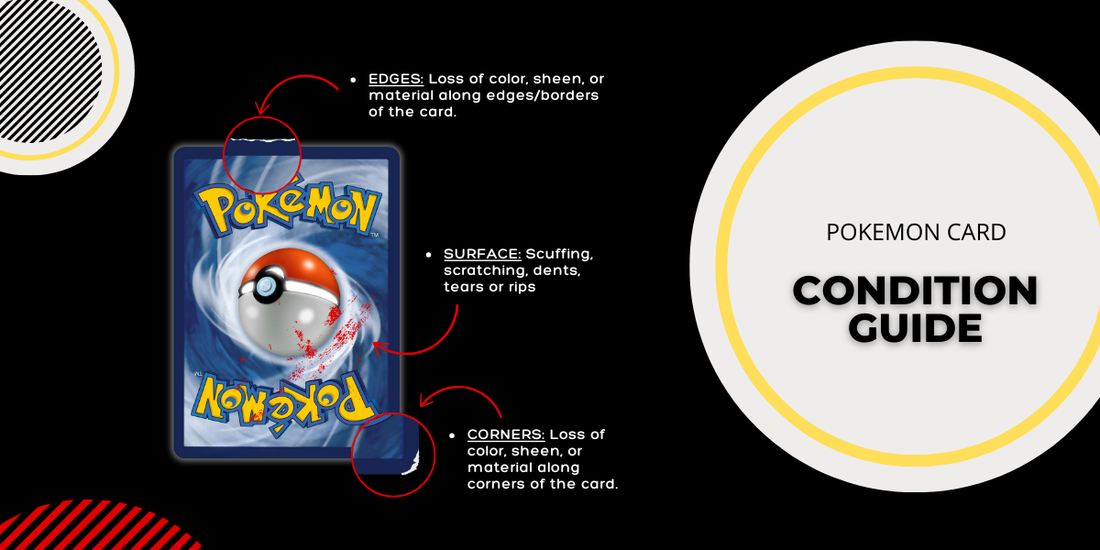
Pokemon Card Condition Guide
The Ultimate Guide to Conditioning and Grading Pokémon Cards
Pokémon card collecting is more than just a hobby; for many, it’s an investment. Knowing the condition of your cards can significantly impact their value and desirability in the collector’s market. This guide will help you understand the key differences between conditioning and grading, and how to properly assess and care for your cards.
Understanding the Basics: Conditioning vs. Grading
Conditioning refers to the process of assessing and maintaining the physical state of your Pokémon cards. This involves looking at factors such as surface quality, corners, centering, and edges to determine how well a card has been preserved. Conditioning is typically done by the collector themselves.
Grading, on the other hand, is the professional evaluation and certification of a card’s condition by a third-party grading service. Graded cards are sealed in tamper-proof cases and given a numerical score (usually from 1 to 10) that reflects their overall quality.
When we condition, we perform an evaluation to determine if a card is within a certain range of imperfections. While measurements and metrics around imperfections and severities are considered, this process does not involve exact measurements. Grading, in contrast, involves numerical evaluations conducted by professional services.
Key Factors in Conditioning Pokémon Cards
To condition your cards effectively, you must pay attention to the following:
-
Surface:
-
Look for scratches, print lines, and other imperfections on the card’s front and back.
-
Avoid placing cards in environments where they could accumulate dust or dirt.
-
-
Corners:
-
Check that all corners are sharp and free from bends or whitening.
-
Use sleeves and top loaders to prevent corner damage.
-
-
Edges:
-
Examine the edges for signs of wear or chipping.
-
Handle cards by the sides to avoid unnecessary pressure on the edges.
-
-
Centering:
-
Proper centering means the borders on all sides of the card are even.
-
Cards with poor centering may still be valuable but will not receive top grades.
-
-
Card Backs:
-
The back of the card is just as important as the front.
-
Inspect for fading, whitening, or any defects that could impact condition.
-
Card Condition Guide
The condition of a card is determined by the number and extent of imperfections. Imperfections are any atypical printing or manufacturing defects, and any wear or damage to the card after the printing process. Imperfections are characterized by both a Type (e.g., scratch) and a Severity (e.g., slight).
Near Mint (NM) / Near Mint Foil:
-
Minimal wear from shuffling, play, or handling.
-
Nearly unmarked surface, crisp corners, and unblemished edges.
-
Slight edge wear or a minor scratch is acceptable.
Lightly Played (LP) / Lightly Played Foil:
-
Minor border or corner wear, scuffs, or scratches.
-
No significant structural issues, but visible imperfections.
Moderately Played (MP) / Moderately Played Foil:
-
Noticeable border/corner wear, scratches, scuffs, and whitening.
-
Creases or small imperfections that do not affect card integrity.
Heavily Played (HP) / Heavily Played Foil:
-
Major wear, creasing, whitening, and bending.
-
Flaws impacting structural integrity, but card remains playable.
Damaged / Damaged Foil:
-
Severe imperfections such as tears, heavy creases, or surface damage.
-
May not be legal for tournament play.
Foils and Foiling
Foil versions of cards are evaluated by the same criteria as non-foil cards. However, imperfections are more noticeable on foils. Curling is common in foil cards and should not exceed 5mm of flex. Borderline foil cards are often downgraded compared to non-foils.
How to Maintain and Protect Card Condition
-
Use Protective Sleeves and Top Loaders: These provide an essential layer of protection against bending, dirt, and scratches.
-
Store Cards in a Cool, Dry Place: Excessive heat or humidity can warp cards and damage their surface.
-
Avoid Direct Sunlight: Prolonged exposure can fade the card and diminish its value.
-
Handle Cards with Clean Hands: Oils and dirt from your hands can affect the card surface over time.
The Grading Process Explained
Grading services such as PSA, CGC, and Beckett use specific criteria to assign grades to Pokémon cards. Here’s what to expect during the grading process:
-
Submission:
-
You send your card to a grading service through their submission process.
-
-
Evaluation:
-
Experts assess the card’s surface, edges, corners, and centering under high magnification.
-
-
Encapsulation:
-
The card is sealed in a secure plastic case to prevent further damage.
-
-
Grading Scale:
-
Grading scales typically range from 1 (Poor) to 10 (Gem Mint). The higher the grade, the more valuable the card.
-
When to Condition vs. When to Grade
-
Conditioning is essential for cards in your personal collection or those you plan to trade informally.
-
Grading is recommended for rare, vintage, or high-value cards to preserve their authenticity and value.
By understanding the differences between conditioning and grading, you can make informed decisions about your Pokémon card collection. Proper care and attention to detail will help maintain your cards' value for years to come.
